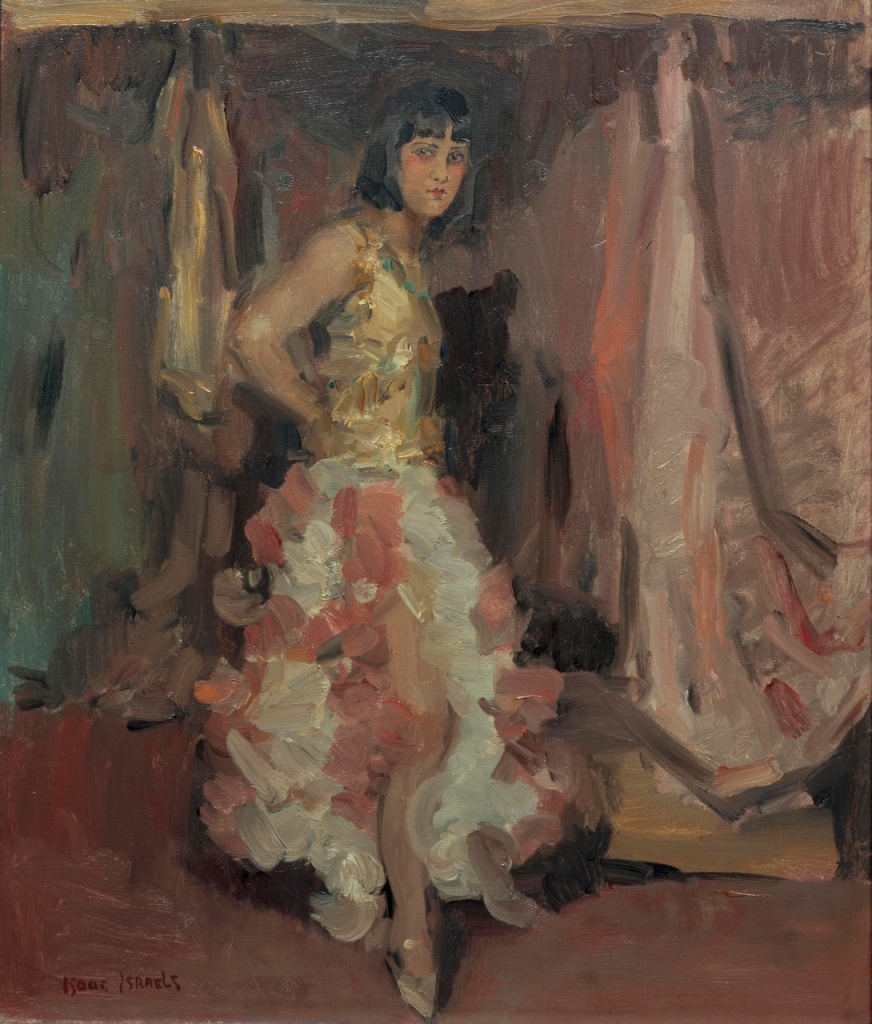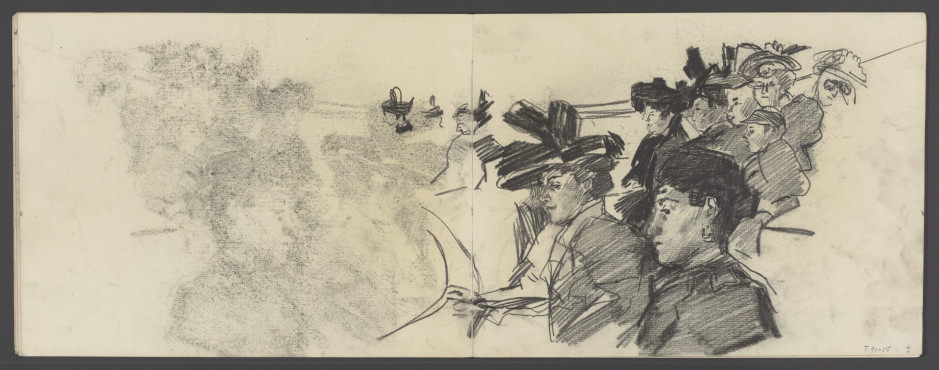The prolific Dutch impressionist Isaac Israels was inspired by dance throughout his entire career. The previous four posts discussed many of his dance images, ranging from girls dancing in cafés, Spanish dancing, young ballerinas, dancers at Le Moulin de la Galette to ethnic and revue dancers. This post, the last in a series about Isaac Israels, will look at a number of portraits of well-known and anonymous dancers. The term portrait often refers to a representation of an influential, wealthy or historical figure. I, however, will use the term loosely, considering Israels works where he places a dancer in the focus of attention. The self portrait, shown below, is an interesting starting point.
Isaac Israels dominates the painting; his self portrait occupies the entire right half of the canvas. In the background, taking a prominent place, is a canvas showing a Javanese dancer accompanied by a gamelen orchestra. Israels’ first introduction to the Dutch East-Indies culture was at an exhibition held in 1898. Some years later, in 1916, Israels attended a charity performance where Javanese music and dance was performed. There, Raden Mas Jodjana, a performer of noble birth, danced a programme of Javanese dances. Israels, most impressed, painted various images of the successful dancer; one of which closely resembles the painting shown in the self portrait. He also painted a second self-portrait featuring a full length sketch of Raden Mas Jodjana.
Javanese dancer, Raden Mas Jodjana – oil on canvas c. 1915 – Van Abbe Museum, Eindhoven
Javanese dancer Raden Mas Jodjana – oil on canvas – 82 x 135 cm – c. 1916 – Museum Boijmans van Beuningen, Rotterdam
In these two portraits, as in a number of other portraits, Israels captures the overwhelming serenity and dignity of Raden Mas Jodjana. The dancer, dancing a traditional Javanese court dance, stands motionless, projecting calm, courtly grandeur. Besides their working relationship Raden Mas Jodjana and Israels became friends; this friendship encouraged the then fifty-six-year-old Israels to travel to Nederlands East-Indies. He arrived in Batavia in 1921 and stayed there until October 1922 painting court dances and dances performed in villages and towns.
Serimpi dance – classic court dance – Kraton (palace) Java – watercolour on paper, 51×41 cm – 1921-22
Balinese dancer – painted during visit to Bali – 1921-22
With an introduction from Raden Mas Jodjana, a member of the royal family, Israels was granted permission to paint at the Kraton of Mankoenegara VII in Surakarta. This gave him a magnificent opportunity to paint the serimpi dance, a classic court dance, traditionally performed by princesses in the seclusion of the palace. The movements are languid, fluid, the epitome of modesty and courtliness. The beautiful watercolour (left), depicted in Israels’ customary quickly sketched lines and splashed with blobs of paint, highlights the young girl’s spirituality. The vague, though slightly distinguishable surroundings further underline the otherworldliness; her cool serenity contrasting sharply to the vivacious dancer from Bali. This alluring dancer is down to earth. As far as I can make out, she is dancing in public on a makeshift stage. Behind her, seated on the floor, are two more dancers. Except for the exaggerated hip movement, nothing in her provocative pose is reminiscent of Balinese court dance. Israels, as we have seen, always sought to paint everyday situations of ordinary people. This dancer, in a stunning orange dress enhanced with gold coloured accessories, is not the highly stylized, elegant court dancer, but an entertainer dancing on an improvised stage in some village or town in early 20th century Bali.

There is no escaping; the eyes of this stunning figure demand attention. Provocative, resolute and dauntless are a mere three adjectives that describe this ravishing woman. Slowly the painting unfolds. This is a half portrait of a showgirl working at the Scala Theatre in The Hague. Her penetrating eyes, the focus, the suggestive bare shoulder and the forcefully folded arms are confronting. And that red feathered headdress, which expands even beyond the canvas, makes the showgirl appear longer and more imposing. Israels uses a colour scheme, not dissimilar to the Balinese dancer, with a variety of orange, red and yellow tints. The bold personality of the showgirl is heightened by a dramatic use of these warm colours; the red costume boosted with gold embellishment is beguiling. Israels adds further drama by candidly placing this defiant showgirl in front of a disorderly backdrop; a facade of swiftly executed brownish smudges and brush strokes.


Dancer – c.1913-15 – oil on canvas – 41.6 x 71.7 cm – Museum Boijmans van Beuningen, Rotterdam
Standing Dancer – 1900-1934 – oil on canvas – 70 x 60 cm – Centraal Museum, Utrecht
(click on image to expand)
Israels loved all forms of entertainment, and was especially spellbound by the glamour and spectacle of the theatre. Whenever possible he was to be found backstage sketching the dancers in the dressing room, waiting in the wings, putting on their make-up or preparing for a performance. The paintings, shown above, are a glimpse into the backstage life of the dancer. In the left painting, made during his stay in London, the dancer poses in a typical ballet position. Beautifully dressed, in what looks like a pink chiffon tunic, this ballerina appears to have been caught unawares, glancing warily at the artist. From the line of her focus I have the impression that Israels in sitting, sketching continually, in the secluded backstage corner. At the back, there is a seated figure, not unlike the stage mothers so often seen in Degas’ ballet paintings. Israels, you will recall, was an ardent admirer of Degas.
If you have a moment, you may like to expand the image to take a closer look at Israels’ signature style; it repeatedly astounds me how his fleeting brush strokes and seemingly nonchalant smears develop into a harmonious whole. The revue dancer, Standing Dancer, is painted in the same technique, but she tells a very different story. This self assured lady willingly, without the slightest hesitation, displays her long appealing leg, even extending her foot deliberately forward so that the onlooker has a really good view. Whereas the ballerina is slightly withdrawn, this lady is not at all bashful. Judging from her bold expression and strong body language she is ready to confront any and every challenge.

Mata Hari, dancer and spy, is a legend. Margaretha Geertruida Zelle (1876-1917) was born in the Netherlands and after a turbulent marriage transformed into the exotic dancer Mata Hari. In 1916, a year before her execution, Mata Hari temporarily lived in The Hague, not far from the Royal Theatre. Isaac Israels lived in the same area. The two had ample opportunity of meeting each other either on the street or in the theatre.
Israels’ full-length portrait of Mata Hari is entirely different to all the well known images we have come to recognize as Mati Hari. All the familiar photographs show an exotic, erotic, semi-clad dancer performing a quasi oriental dance. She is notoriously bejewelled, bewitching and voluptuous. Israels chose to paint a captivating, modern woman. Nothing in this portrait resembles her stage image; Mata Hari is not shown dancing, but she certainly has the allure of a dancer. Israels’ Mata Hari is a tall, confident, charismatic woman, fashionably dressed in a luxurious long coat with matching fur muff. He portrays Mata Hari exclusively in one tone, a fusion of black and brown. This is a total contrast to the elaborate, scintillating costumes she wore during her performances. Just as a matter of curiosity, there is a photograph of Mata Hari taken on the day of her arrest wearing a coat incredibly similar to the one shown in Israels’ portrait. The circumstances, in which the portrait and the photograph were made, are entirely different, but the similarity, both in attire and facial features, is thoroughly staggering.

One final sketch, not of a dancer, rather a group of portraits showing an audience watching a performance. Israels was fascinated by the everyday, and that included audiences enjoying the theatre. Israels was an inexhaustible artist who painted an entire series devoted to one theme, and dance was one of the many themes he loved to embrace. He, more than any other late 19th, early 20th century Dutch artist, illustrated dancers. He portrayed a diversity of dance forms and theatrical entertainment. In this series of posts, about the most important Dutch impressionist, I have but touched on the wealth of Israels work. Israels had an overwhelming interest in all what was going on around him, is fascinated by street scenes and human life as a whole.*
* Isaac Israels – Anna Wagner p.8 Meulenhoff Amsterdam 1969





